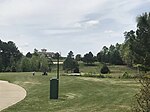Jesse Penny House and Outbuildings
Houses completed in 1900Houses in Wake County, North CarolinaHouses on the National Register of Historic Places in North CarolinaNational Register of Historic Places in Wake County, North CarolinaWake County, North Carolina Registered Historic Place stubs

Jesse Penny House and Outbuildings is a historic home and farm complex located near Raleigh, Wake County, North Carolina. The Penny House was built in 1890, and enlarged in 1900. It is a two-story, single pile, frame I-house with a one-story rear addition. It features a hip-roofed wraparound porch. Also on the property are the contributing well house (c. 1900), barn/garage (c. 1900), barn (c. 1900), chicken house (c. 1900), and picket fence (c. 1900).It was listed on the National Register of Historic Places in 2002.
Excerpt from the Wikipedia article Jesse Penny House and Outbuildings (License: CC BY-SA 3.0, Authors, Images).Jesse Penny House and Outbuildings
Corbarron Court,
Geographical coordinates (GPS) Address Nearby Places Show on map
Geographical coordinates (GPS)
| Latitude | Longitude |
|---|---|
| N 35.711111111111 ° | E -78.701666666667 ° |
Address
Corbarron Court 5390
27606
North Carolina, United States
Open on Google Maps





